Striated Action Marks
Striated
action marks are common to cartridge cases that have passed through the action of an
auto loading or repeating firearm. Striated action marks can be produced
on cartridge cases by contact
with a number of different areas within the firearm. Some of the
more common striated action marks include chamber marks; shear marks,
firing pin drag marks, extractor marks, and ejector marks.
One of the most common striated action marks are called chamber marks.
Roughness in the chamber of a firearm can scratch the outer walls of a
cartridge case when loaded and removed from the chamber. Most chamber
marks occur after the cartridge is fired. Cartridge cases expand
when fired pressing out against the walls of the chamber. When
they are pulled out of the chamber, the sides of the cartridge case can
be scratched. The comparison image below shows chamber marks on
22 caliber, rimfire cartridge cases.
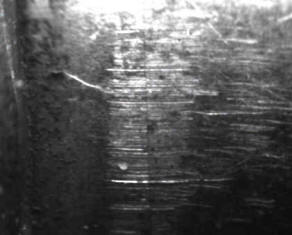
Another
common striated action mark are shear marks produced by GLOCK pistols on
cartridge case primers. GLOCK pistols have a rectangular
firing pin hole (below) in their breech face.
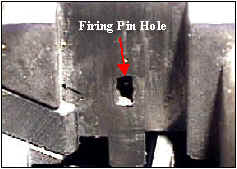
When a
cartridge case is forced backwards from recoil the primer imbeds
itself in the firing pin hole. As the slide of the pistol starts
to recoil, the barrel will drop slightly as the action opens. The
dropping barrel forces the cartridge case to move down slightly and
when this happens the lower edge of the imbedded primer is sheared
downward and out
of the firing pin hole. The resulting striated marks can be seen
in the comparison image below.
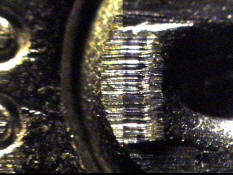
In a
similar process, striated marks called firing pin
drag marks can be produced. When the firing pin springs
forward to strike the primer of a cartridge, it may remain slightly
forward and imbedded in the primer. Certain barrels (like in the
GLOCK) drop down slightly as recoil is forcing the action
open. The cartridge case drops with the barrel causing the nose
of the protruding firing pin to drag across the primer as it leaves the firing
pin impression. The below comparison image shows firing pin drag
marks produced by a Colt 45 AUTO pistol.

Another
action mark, usually found in a striated form, are those created by the extractor
of most auto-loading or repeating firearms. The extractor is a
small part sometimes resembling a hook that is used to remove a
cartridge or cartridge case from the chamber of a firearm. The
image below shows the extractor of a 9mm GLOCK pistol hooked into the
extractor groove of a cartridge. As the slide of the pistol
moves to the rear, the extractor pulls the cartridge case along with it
until it is ejected from the pistol.

The
extractor may or may not leave an identifiable mark on the cartridge
case. This is true if the cartridge is fired or simply hand
chambered and extracted without firing. Extractor marks may look
like those seen in the comparison image below.
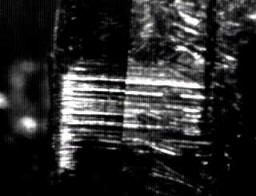
As
described above, the extractor pulls the cartridge case out of the
firearm's chamber. As the cartridge case is pulled to the rear
it will be struck somewhere on an opposing
edge by a part as seen below called the ejector.
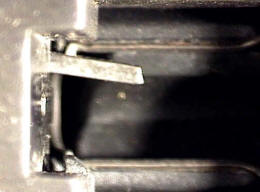
The ejector is
designed to expel the cartridge
case from the action of the firearm. The resulting impact of the
cartridge case with the ejector will cause another action mark that
can be used as a means of identification.
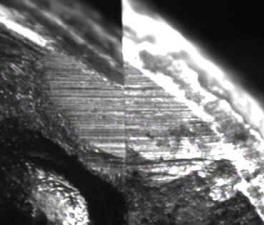
Ejector marks can be
striated in nature but a lot of the time they are impressed action
marks. Click the next button below to learn more
about impressed action marks.
Additional
examples of cartridge case comparisons can be seen in the image
galleries.
|